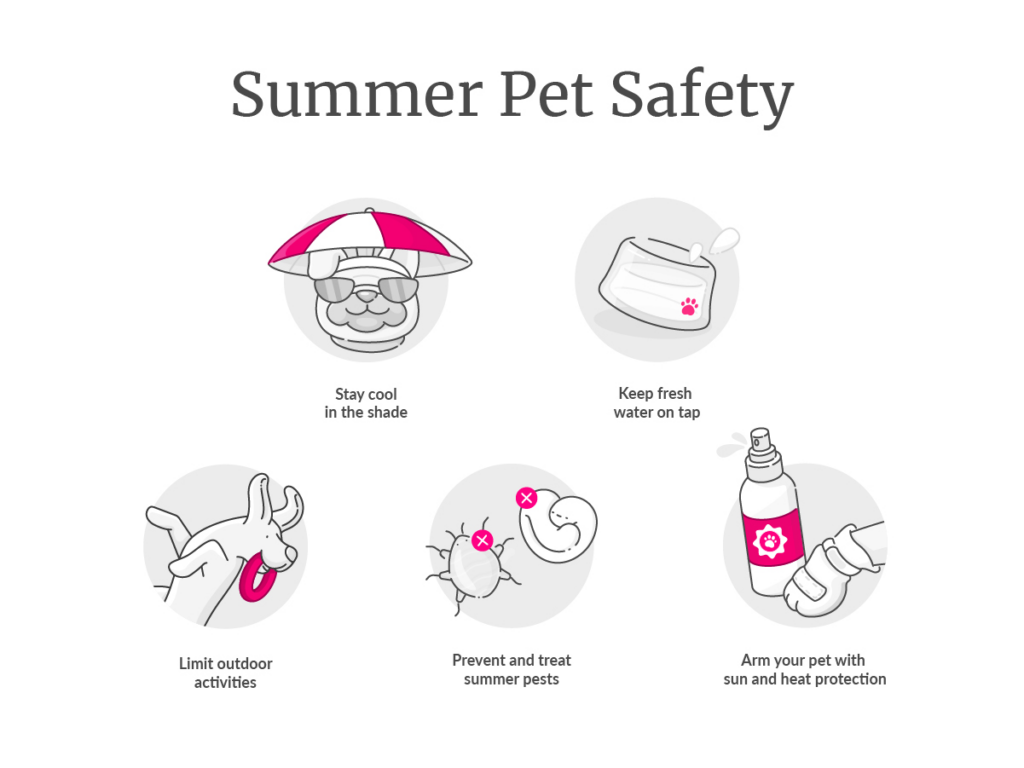Summertime is finally here, and you can’t wait to soak up the sun with your four-legged friend. What cuter companion is there for that morning stroll, frisbee session at the beach, or Pride march?
There’s so much for you and your pet to enjoy together as it gets warmer outside, but hot weather could also put their health at higher risk. We spoke to our favorite veterinarian, Dr. Liff, to learn more about how you can make sure your fur fam can beat the heat and have the best summer ever.

Heat stroke
What is heat stroke?
Our pets don’t sweat like we do, making them overheat more easily—and with more dangerous consequences. The American Animal Hospital Association warns that if the core temperature of your pet gets higher than the normal range (100 – 102.2 degrees), they have heat stroke, which in severe cases can lead to organ failure.
While any pet can be at risk for heat stroke, dogs are much more prone to it than cats, since felines usually hang out indoors, or in the shade.
What are the signs of heat stroke for dogs?
- Excessive panting
- Diarrhea
- Vomiting
- Salivating
- Collapsing
- Feeling warm to the touch
- Temperature of over 102.2 degrees
What dog breeds are at higher risk for heat stroke?
- Short-muzzled dogs with a flattened face (aka Brachycephalic dogs). French Bulldogs, Boxers, and Pugs are at the highest risk of heat stroke
- Plush-coated dogs. Chow Chows, Great Pyrenees, and German Shepherds
- Nordic breeds. Finnish Lapphund, Norwegian Buhund, and Swedish Vallhund
How can I prevent my fur fam from getting heat stroke?
On hot days, keep your pets in a cool place as much as possible, especially if you see them panting. Your dog should always have access to cold drinking water.
Avoid taking your dog out during the hottest parts of the day, between dawn and dusk. On extremely hot and humid days, you should limit outdoor play to 5-10 minutes at a time, or until they’re panting heavily.
If your dog is a strong and enthusiastic swimmer, letting them take a dip in a swimming pool or lake is a great way to burn energy on a hot day. As long as your pup doesn’t overdo it with the doggy paddle, there should be a lower risk of overheating here than with other forms of exercise.
If you have a rectal thermometer for your pet (and your pet can stay calm while having their temperature taken), you can monitor if their temperature is staying within the normal range. Any temperature over 102.2 degrees means your pet is overheating, while 105 degrees warrants an emergency vet visit, even if your pet is acting normal.
What should I do if my dog has heat stroke?
If you see signs of your pet having heat stroke, get them to the emergency vet ASAP.
Depending on the severity, treating your pet for heat stroke could require a multi-day hospital stay in the ICU and might involve blood product transfusions, which could cost $5,000–15,000 or more.
Even after your pet is on the road to recovery, you may still feel the heat from the vet bill that comes along with emergency treatment. When you buy a Lemonade dog health insurance policy, a base accident and illness policy could help cover the costs of your pet’s care if they have heat stroke.
Sunburn and paw protection

What are the signs of sunburn on dogs?
News flash: Having a fluffy coat of fur doesn’t make your pup immune to sunburn. Just like humans, dogs’ skin is sensitive to the sun.
Here are some sunburn reactions to look out for on your pooch:
- Red skin, sensitive to the touch—especially on noses, ears, and tummies
- Dry, cracked skin
- Whimpering in pain when you pet them
- Slight fever
- Curled edges on their ears
- Hair loss
- Skin ulcers
- Skin infections
Can my dog get skin cancer from sun exposure?
All pets are at risk for skin cancer. Dr. Liff says that sun-induced cancers among dogs are less common than for people. More common skin cancers on dogs—like melanoma and mast cell tumors—are rarely related to sun exposure.
What dog breeds are at higher risk for sunburn?
Dogs with short coats and pink skin are more likely to get a sunburn, including:
- Collies
- Australian Sheepdogs
- Dalmatians
- Bulldogs
- Whippets
How can I prevent my fur fam from getting a sunburn?
Minimize their sun exposure. On hot days, make sure your pooch has access to a shade covering or shelter with good air circulation and lots of water.
There are plenty of dog-friendly sunblocks and sunscreens on the market that can add an extra layer of protection. Check out some hot picks here. Dr. Liff recommends spray formulations for optimal coverage—just be sure to shield your dog’s eyes when applying.
What should I do if my dog gets a sunburn?
Dr. Liff says that most of the sunburn cases that she sees are mild redness on the skin, which can be soothed by applying aloe vera directly on the skin.
Treatment varies depending on severity of the burn. This could be cortisone ointment to reduce inflammation or an antibacterial and antifungal topical to prevent infection. Don’t self-medicate your dog’s sunburn. Ask your vet what’s the best treatment.
How can I protect my dog’s paws on a hot day?
Walking your dog on hot surfaces—like pavement, asphalt, or artificial grass—can be harmful to their sensitive paws. If these surfaces are too hot to the touch for your own hand or foot after a few seconds, they’re definitely too hot for your dog’s comfort. After all, just think of how miserable you might get walking barefoot on a scorching-hot sidewalk.
Take your dog out early in the day to help avoid pain, blistering, and a potential vet visit later. Also, check out some best selling paw protectors—like socks, boots, paw pads, and balms. (If your dog’s a sneakerhead, well… there’s a brand for that.)
Sitting or lying down on hot surfaces could be even more dangerous and even fatal for your fur fam. When a dog stays on a hot surface too long, their core temperature heats up, and can lead to heat stroke.
What does my dog need for a full-day outing?
Bring along an activity pack for them that includes:
- Water
- Collapsible water bowl
- Cooling mat
- Shade covering—like a tent
- First aid kit
- Snacks (for less than eight hours) or a full meal plus snacks (for more the eight hours)
Set limits on the time and intensity that you’ll expose your dog to the heat, sun exposure, and crowds. Even if you can tolerate the heat all day, it doesn’t mean your dog can or should. If the weather is mild, and depending on the energy level and temperament of your dog, you could include them in outdoor activities for four to six hours.
Pests and Disease
Bug bites, bee stings, and tick-borne illnesses flourish as it gets warmer outside. There is also an increase in skin-related issues for dogs that swim in pools, lakes, or the ocean.
Dr. Liff recommends that pet owners discuss with their vet their specific regional and seasonal concerns related to pests and disease. Consult with a professional on things like flea and heartworm prevention and treatment.
When you buy a Lemonade Pet policy and add the Preventative+ package, you can help set your pet up for a healthy and happy summer without breaking the bank. With this package, Lemonade could help cover up to 90% of your vet bills—for things like vaccines, annual heartworm screenings, and medications for pests like fleas and ticks.
Hydration and Diet
Dehydration is a risk for pets, especially in warm weather. Your fur fam should always have access to plenty of fresh, cool water. Get a collapsible travel dog bowl so that you can always pour your pal a drink.
Notice that your pooch isn’t drinking enough water? Try adding low sodium broth or water to their food. Also, ice cubes may be more fun to play with than drinking water.
If your dog is showing signs of dehydration—like sunken eyes, loss of appetite, panting, or a dry nose—call your veterinarian or the nearest animal emergency center immediately.
As for what your dog is eating in the warm months, their diet generally shouldn’t change during the summer. If you notice that your high-energy dog is unable to maintain their weight in the heat, they may need a higher calorie intake.
Managing a day at the beach

Check the temperatures for the day before including your four-legged friend on a beach day. (And check local regulations to make sure your pup is even allowed on the sand.) Even if it’s a cooler day, bring a shade covering to protect your dog from too much sun exposure and give them a safe place to rest and cool down. They should also have access to plenty of fresh drinking water.
No matter how careful your dog is during a beach outing, they will inevitably ingest some sand and salt water, which can be dangerous depending on how much they consume.
If your pooch ingests too much seawater, they could be at risk of saltwater toxicity—aka hypernatremia. Early signs of hypernatremia are vomiting and diarrhea. In more serious cases, dogs can suffer neurologic abnormalities and even death. If your dog starts exhibiting these symptoms, get them to the vet immediately.
Natural disaster preparedness
You might already have a plan for storm season to keep you and your human loved ones safe—like drafting an evacuation plan, packing an emergency kit, and securing your home. It’s also important to include your fur fam in these worst-case scenario preparations.
Keep at least five to seven days of your pet’s food on hand, in addition to plenty of fresh water. If your pet takes medication, you should have at least 30 days of medication at home.
We also recommend keeping a recent copy of your pet’s medical records and rabies certificate handy. If you need to evacuate to a shelter, you will need to prove ownership and the vaccination status of your pets to bring them along.
Dog grooming
Dogs with longer coats could benefit from a haircut during the hotter months—especially if they like to swim. Not only will they dry faster, preventing that “wet dog” smell, a shorter hairdo reduces their risk for rashes that develop from a wet undercoat.
Surprisingly, trimming a long-coated dog generally won’t reduce their risk of overheating.
Even though a haircut won’t do much to cool your pup down, the summer is always a great time to experiment with a new look.
At home
Even if your dog stays indoors during the hottest months, they can still overheat and dehydrate.
Leave the air conditioning on during sweltering days. They should have access to their regular type and amount of food, and a constant supply of fresh water.
Make sure that they get sufficient outdoor bathroom breaks (and try to schedule those trips during the cooler parts of the day, like at dusk and dawn).
Worried your pets will get bored staying at home when it’s too hot to go out and play? Dr. Liff recommends food puzzles to help with mental stimulation. They’re available in all shapes and sizes; here are some top picks according to New York magazine. There are also DIY ideas if you want to create makeshift cognitive toys with regular household items—like a treat dispenser made out of a toilet paper roll.
Beat the heat
You’re a great pet parent, and you’re ready to em-bark on the best summer ever with your fur fam. Set your pooch up for success with things like a collapsible water bowl to keep them hydrated no matter where you are, sunblock and paw pads to protect their sensitive skin from sun exposure and heat, and a Lemonade Pet policy to help cover the costs of keeping them safe and healthy.
Click the button above, or get started in our mobile app on your iPhone or Android. From there, Lemonade’s friendly AI chatbot, Maya will ask you a few simple question about your four-legged friend so you can lock-in the best pet insurance to cover your pet—and your wallet.
A few quick words, because we <3 our lawyers: This post is general in nature, and any statement in it doesn’t alter the terms, conditions, exclusions, or limitations of policies issued by Lemonade, which differ according to your state of residence. You’re encouraged to discuss your specific circumstances with your own professional advisors. The purpose of this post is merely to provide you with info and insights you can use to make such discussions more productive! Naturally, all comments by, or references to, third parties represent their own views, and Lemonade assumes no responsibility for them. Coverage and discounts may not be available in all states.




